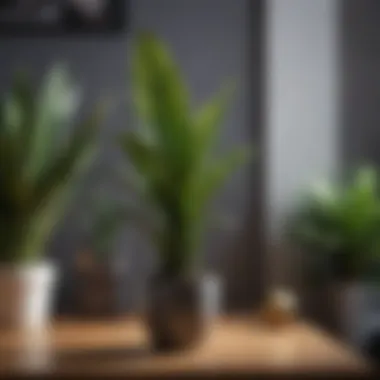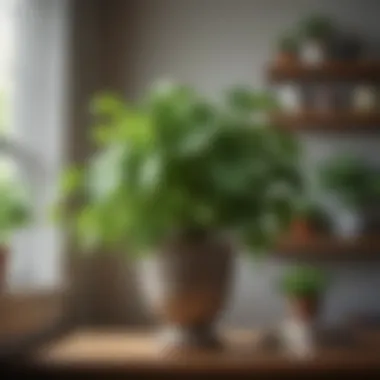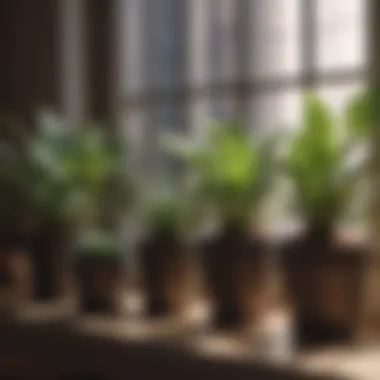Indoor Plants That Thrive in Low-Light Conditions


Intro
Indoor plants that require minimal sunlight are an optimal choice for many residents living in urban and shaded areas. Such plants not only adapt well to lower light conditions but also enhance the ambiance of indoor spaces, contributing to both aesthetics and air quality. Understanding how these plants thrive can assist even the most inexperienced indoor gardeners in fostering a green sanctuary at home. In this article, we will explore various species that flourish in low-light conditions, their care, and the benefits they offer.
Plant Profile
General Overview
Many plants can survive without abundant sunlight, which is beneficial for people who do not have access to bright windows or outdoor gardens. Popular low-light species include the snake plant, pothos, and peace lily. These plants possess unique features that allow them to effectively photosynthesize and grow even in dim conditions.
Habitat and Distribution
These plants originate from various regions around the globe. For instance, the snake plant is native to West Africa, while pothos is from the Solomon Islands. Their natural habitats typically include dense forests where they receive filtered light, making them well-suited for indoor living.
Fascinating Facts
Unique Traits and Adaptations
Plants that thrive in low light often have darker green leaves, which contain a higher concentration of chlorophyll. This trait enhances their ability to absorb the available light more efficiently. Moreover, some species have larger leaves that maximize surface area for light capture.
Historical and Cultural Significance
Throughout history, indoor plants have played significant roles in various cultures. The peace lily, for example, is revered in some traditions for its ability to purify the air and create a serene environment.
Conservation Status
Current Population Trends
While many low-light plants are readily available for cultivation, it is important to consider their propagation and conservation. The demand for certain species can impact natural habitats. Thus, sustainability should be a focus for both gardeners and suppliers.
Threats and Challenges
Habitat destruction remains a major threat to plant species worldwide, including those that are popular in indoor environments. Urban expansion and deforestation create challenges for the survival of these plants in their native settings.
Care Tips for Plant Owners
Basic Needs and Requirements
Caring for low-light indoor plants requires some attention to detail:
- Watering: Overwatering is a frequent mistake. Most of these plants prefer to dry out slightly between waterings.
- Humidity: Some low-light plants thrive in higher humidity. Consider misting or using a humidity tray.
- Fertilization: Use a balanced fertilizer during the growing season to promote healthy growth.
Health and Wellness Tips
Regularly inspect your plants for pests and diseases. Early detection can prevent larger issues later on. Creating a clean environment around the plants and properly pruning them can contribute to their overall health and vitality.
It is crucial to understand the specific needs of each plant species, considering that they may offer various benefits for your indoor space. Incorporating low-light plants into your home can greatly enhance the quality of your living environment while requiring minimal maintenance.
Foreword to Low-Light Indoor Plants
In an urbanized world, many dwellers find themselves in spaces with limited sunlight. The concept of low-light indoor plants becomes increasingly relevant as individuals seek to bring nature indoors without the necessity for ample natural light. Understanding the dynamics of low-light environments is crucial for successfully incorporating greenery into these spaces.
Understanding Low Light Conditions
Low light conditions typically refer to environments that receive insufficient exposure to direct sunlight. This can be common in apartments with small windows or in offices that rely heavily on artificial lighting. Low-light conditions can range from areas that receive no direct sunlight at all to those that get just a few hours of indirect light each day.
Plants have adapted unique mechanisms to thrive under these circumstances. They often possess larger leaves or more efficient photosynthetic processes that allow them to capture and utilize the limited light available. Furthermore, the timing of exposure to light matters. Many low-light plants can perform photosynthesis effectively even when receiving light sporadically. This adaptation is essential for survival in shaded forest environments, leading to successful growth in indoor settings.
Benefits of Having Indoor Plants
Incorporating indoor plants into low-light spaces offers many benefits that go beyond aesthetics. Some advantages of having these plants include:


- Improved air quality: Indoor plants can filter toxins, resulting in cleaner air, which is particularly beneficial for urban residents.
- Mental well-being: Exposure to greenery has been linked to reduced stress levels and improved mood. The presence of plants can create a calming atmosphere, ideal for homes and workplaces.
- Increased productivity: Several studies find that having plants in workplaces can enhance focus and efficiency, promoting a better working environment.
- Enhanced aesthetics: Low-light plants can serve as appealing decor, adding a touch of nature and color to any space.
Having plants in indoor spaces is not merely an aesthetic choice. They significantly contribute to the overall health and well-being of individuals living or working in those environments.
Overall, low-light indoor plants provide a practical solution for those struggling with limited sunlight exposure while enhancing both the environment and the quality of life. Understanding these key elements sets a foundation for selecting and nurturing the right plants for any low-light scenario.
Characteristics of Low-Light Plants
Understanding the characteristics of low-light plants is essential for anyone who wishes to incorporate greenery into spaces where natural light is limited. In urban settings or homes with small windows, selecting plants that can thrive without much sunlight becomes vital. These characteristics ensure that plants not only survive but can also contribute positively to indoor environments.
Adaptations for Survival
Low-light plants have specialized adaptations that enable them to survive under minimal sunlight. One key adaptation is the ability to maximize photosynthesis using the little light they receive. These plants often exhibit broader leaves that can capture more light effectively. Furthermore, many of them have a slower growth rate, allowing them to conserve energy when light is scarce. Their deep root systems are also significant. Roots that reach wider areas permit these plants to access moisture and nutrients even in less-than-ideal conditions.
Some low-light plants, like the ZZ Plant and Snake Plant, have also developed storage mechanisms in their leaves or stems. This allows them to store energy during better lighting conditions, which they can later utilize when sunlight is insufficient. These adaptations culminate in a resilience that makes them ideal for indoor spaces where light cannot be guaranteed.
Common Features to Look For
When identifying low-light plants, some common features are particularly indicative of their adaptability. These include:
- Leaf Structure: Look for plants with thick, sturdy leaves. These tend to have a waxy coating that reduces water loss, a crucial feature in low-light environments.
- Color Variation: Many low-light plants exhibit darker green foliage. A deeper color ensures that the plant can absorb more light. Conversely, lighter or variegated leaves are often less effective at photosynthesis.
- Growth Habit: Low-light plants typically grow tall and upright or spread wide. This growth habit allows them to utilize available light more efficiently. Examples include the Peace Lily, which rises elegantly in search of any light source.
When selecting plants for low-light conditions, ensuring they possess these characteristics will lead to better outcomes. They will not only survive but also thrive, bringing life to otherwise dull spaces.
Incorporating low-light plants into your living or working area can greatly enhance the ambiance and improve indoor air quality.
Best Indoor Plants for Low Light
Finding indoor plants that require minimal sunlight is crucial for those who live in spaces with limited natural light. These plants can enhance the aesthetic of the home or office while improving indoor air quality. Understanding the characteristics and specific care needs of low-light plants allows individuals to make informed choices. This section explores several popular indoor plants that thrive under low light conditions, detailing their unique benefits and care considerations.
Snake Plant
Care Requirements
The Snake Plant, also known as Sansevieria, is highly regarded for its ability to adapt to low light environments. This plant requires minimal attention, making it a perfect choice for busy individuals. It thrives in well-drained soil and can endure irregular watering. The key characteristic of the Snake Plant is its thick, upright leaves. This structure allows it to store water efficiently, which directly contributes to its survival in low-light settings. One unique feature of its care requirements is that it can tolerate drought, reducing the frequency of watering. However, overwatering can be harmful, leading to root rot. This makes it essential for caregivers to strike a balance in their watering practices.
Common Issues
Common issues with Snake Plants include yellowing leaves and root rot. Yellowing often indicates overwatering, while root rot can occur when the plant is left in soggy soil. The Snake Plant's resilience is beneficial in that it can withstand some neglect, allowing it to bounce back once proper conditions are restored. Recognizing signs of distress early can help mitigate these problems promptly, ensuring the plant remains healthy in low-light environments.
Pothos
Growth Habits
Pothos, or Epipremnum aureum, is known for its trailing vines and heart-shaped leaves. It is a very hardy plant that can adapt well to different light levels, even thriving in low-light conditions. The growth habit of Pothos makes it a versatile choice for various indoor settings, whether hanging in a pot or placed on a shelf. Its ability to purify air adds to its appeal, making it beneficial not just visually but also health-wise. The unique feature of its growth is that it can stretch toward available light, showcasing its adaptability. However, too little light may slow growth, so balance is key to vibrant foliage.
Maintenance Tips
Pothos requires minimal maintenance, including occasional pruning to promote fuller growth. The ideal watering strategy involves allowing the top layer of soil to dry out completely before rewatering. Regularly checking soil moisture helps prevent overwatering and ensures the plant thrives. Another distinct aspect of Pothos is its resilience against pests; it can often outlive minor infestations without much intervention, making it an optimal choice for indoor gardening.
ZZ Plant
Ideal Conditions
The ZZ Plant, or Zamioculcas zamiifolia, enjoys low light and can adapt to a variety of indoor environments. Ideal conditions for the ZZ Plant involve indirect sunlight and moderate temperatures. The waxy, dark green leaves add an appealing aesthetic, while its drought tolerance further enhances its low-maintenance nature. A major advantage of the ZZ Plant is its ability to survive long periods without water, making it a reliable choice for those with busy lifestyles.
Handling Neglect
Handling neglect is one of the ZZ Plant's strongest traits. It tolerates neglect better than many other plants, which is beneficial for those who may forget to care for it. If neglected, it will show signs, such as yellowing leaves or wilting. However, with proper care reinstated, it can recuperate quite well. This resilience makes the ZZ Plant an excellent introduction for novice plant keepers seeking low-light options.
Philodendron
Varieties


Philodendrons are known for their diverse species, with many thriving in low-light settings. Varieties such as Heartleaf Philodendron and Philo Birkin are popular for their unique foliage. The key characteristic of these plants is their climbing or trailing nature. This allows them to decorate indoor spaces beautifully while benefiting from lower light conditions. Each variety brings a different texture and style to the table, allowing for personal preference in plant selection.
Watering Needs
Watering needs for Philodendrons involve allowing the top inch of soil to dry before applying more water. This method helps prevent overwatering, a common mistake with houseplants. The unique feature of Philodendrons is their ability to indicate when they need water through drooping leaves. This characteristic aids caregivers in timing their watering schedules effectively, ensuring the plant remains healthy and vibrant.
Cast Iron Plant
Durability
The Cast Iron Plant, known scientifically as Aspidistra elatior, is famously durable. It can withstand neglect, poor lighting conditions, and even fluctuating temperatures. This resilience makes it suitable for environments where other plants might fail. Its ability to thrive under these conditions makes it a cornerstone for low-light plant enthusiasts. They are ideal for beginners who may not have the experience to care for more delicate species.
Environmental Adaptability
One of the standout features of the Cast Iron Plant is its remarkable adaptability to different environmental conditions. It can endure dusty, low humidity, and low light, making it particularly suited for indoor settings. Its tough nature means it does not require much fussing over, allowing a diverse range of individuals the opportunity to grow it successfully. However, poor air circulation can lead to fungal issues, so placing it in a location with indirect airflow is beneficial.
Peace Lily
Flowering Period
The Peace Lily, or Spathiphyllum, is renowned for its elegant white flowers. It flourishes in low-light conditions, featuring a long flowering period that can surprise many. The flowers are just as much an attraction as its foliage, helping to brighten indoor spaces. One key advantage is its air-purifying capabilities, making it a popular choice for health-conscious individuals. The unique ability to bloom even in shaded areas sets it apart from many other plants.
Care Essentials
Care essentials for Peace Lilies include keeping the soil consistently moist but not soggy. It is also essential to provide the right balance of humidity. Higher humidity levels can enhance growth and flowering. The notable aspect is that the leaves will droop if the plant needs water, providing a clear, visual cue. This characteristic assists in maintaining its health and ensures it thrives even in less-than-perfect conditions.
Spider Plant
Propagation
The Spider Plant, or Chlorophytum comosum, is famous for its offshoots or 'pups' that grow from the main plant. Propagation is straightforward, making this plant popular for those looking to expand their indoor garden. Its ability to produce many new plants from a single parent contributes to its charm and practicality. However, it's worth noting that these pups need to be removed carefully to ensure the health of both the parent and the new plants.
Growth Patterns
Spider Plants exhibit a unique growth pattern, with long, arching leaves. They can thrive in various conditions but particularly excel with indirect light. This flexibility allows them to be placed in various indoor locations. Their overall hardiness and growth patterns make them suitable for both novices and experienced plant keepers. Importantly, they can also adapt to less-than-ideal conditions, which adds to their appeal.
Care Tips for Low-Light Indoor Plants
Caring for low-light indoor plants can seem daunting, yet it is essential for their growth and overall health. Understanding proper care tips will help you create an environment where your plants can thrive, even in the absence of abundant sunlight. These tips cover watering, fertilization, and potting, each focusing on ensuring plants receive what they need to flourish in low-light conditions. Effective care not only supports the health of the plants but also enhances their aesthetic appeal in your living or working space.
Watering Recommendations
Watering is a critical aspect of plant care, and low-light plants have specific needs. These plants often require less frequent watering than their high-light counterparts. Overwatering can cause root rot, a common issue for many indoor plants. To gauge when to water, it is best to check the top inch of the soil for dryness. If it feels dry, it is time to water.
Also, water should be delivered directly to the soil rather than over the leaves. This method prevents moisture from sitting on the foliage, which can lead to fungal issues. Ensure that the pot has drainage holes; this will allow excess water to escape, providing a healthy environment for the roots.
Fertilization Strategies
Fertilization plays an important role in maintaining vibrant growth in low-light plants. While they require less fertilizer than other plants, applying nutrients is still a must. During the growing season, which is typically spring and summer, using a balanced liquid fertilizer diluted to half strength can be beneficial. A good choice is a fertilizer such as Miracle-Gro Indoor Plant Food, which provides essential nutrients without overwhelming the plants.
In fall and winter, when plants are often dormant, reduce fertilization significantly or stop altogether. This approach prevents unnecessary stress on the plants, aligning their nutrient intake with their growth cycles. Regularly checking the plant's health and adjusting the fertilization routine accordingly is essential.
Potting and Soil Selection
Selecting the right pot and soil for low-light plants is critical for their success. Choose pots with adequate drainage to prevent water accumulation. Terracotta pots are often a good choice because they allow evaporation, which can help keep the roots from sitting in water.
For soil, it is better to use a well-draining potting mix. A blend that includes peat moss, perlite, or vermiculite can be effective. This mix will provide essential aeration and moisture retention, creating a healthy environment for your plants. Moreover, repotting should be considered every couple of years to refresh the soil and provide more space for growth.
“Proper care is as vital as the selection; healthy plants bring life to any space.”
Implementing these care tips can significantly impact the health and appearance of your low-light indoor plants. Each aspect from watering to fertilization and potting is interconnected, and understanding them will help you succeed in nurturing your greenery. Thus, you can create a thriving indoor environment even in limited sunlight conditions.
Potential Challenges with Low-Light Plants


Low-light plants appear to be low-maintenance, but they do present unique challenges. Understanding these challenges is essential for anyone who wants to succeed in growing these plants. Identifying problems early can save a plant from stress and potential death. Thus, recognizing potential challenges is crucial for maximizing the benefits of indoor greenery.
Identifying Plant Stress
Plant stress can manifest in several ways, all of which could signify deeper issues within your care routine. Key indicators include yellowing leaves, which may suggest overwatering or insufficient light despite being considered low-light plants. If the leaves are dropping, it may mean that the plant is either too dry or being exposed to sudden temperature changes.
Other signs include slow growth or stagnant growth patterns. Plants that are not thriving might struggle to develop new leaves or shoots. Faded or deformed leaves can also indicate that the plant is not receiving adequate nutrients or has been affected by a pest. Careful attention to these symptoms is paramount, as identifying stress can help direct how you adjust care strategies.
Common Diseases
Indoor plants are not immune to diseases, even under low-light conditions. Root rot is a frequent issue, mainly caused by overwatering. It often leads to a mushy root system, which is often irreversible. The most effective way to prevent this is to ensure that pots have proper drainage. Watch out for fungal infections, especially in humid environments, leading to leaf spots or blight.
Pest infestations are another concern. Aphids, mealybugs, and spider mites can target indoor plants. Regular inspections of leaves can help catch these visitors early. Treatment may involve insecticidal soap or neem oil, both effective against various pests. Ensuring the cleanliness of your plants and their surrounding area can also reduce the risk of diseases.
By understanding common issues, you can provide a better environment for your low-light plants. Monitoring their health not only improves aesthetics but also promotes a healthier indoor ecosystem.
These considerations highlight the complexity behind seemingly simple low-light plants. Addressing issues of stress and disease is vital for maintaining healthy plants that can thrive in low-light environments.
Case Studies: Successful Low-Light Indoor Plant Setups
Understanding how low-light indoor plants perform in real-world settings can greatly enhance one’s appreciation for these resilient species. By reviewing effective setups in both apartments and office environments, we can identify key strategies and benefits that make these plants ideal choices for urban living. Such case studies also illuminate practical challenges and provide tailored solutions which can make plant care successful in less-than-ideal lighting conditions.
Apartment Living
In urban environments, many apartments feature limited natural light, making it difficult to sustain traditional houseplants. Those who succeed in this setting typically create a harmonious balance between aesthetic appeal and the plants’ care needs. For instance, a small studio apartment can transform its corners and windowsills with a few choice low-light plants. Snake Plants and Pothos are popular because they adapt well to various light situations.
The importance of choosing the right plant types cannot be overstated. In various case studies, residents have reported success with placing their plants near north-facing windows or in corners with indirect lighting.
Benefits:
- Improves air quality by filtering toxins.
- Adds greenery to otherwise stark spaces.
- Promotes a calming atmosphere.
Care considerations include ensuring proper watering schedules and occasional fertilization during growing seasons to support plant health. Observational strategies, such as assessing leaf color and growth patterns, can help apartment dwellers understand whether their plants thrive or suffer.
Office Environments
Office spaces often lack natural light due to fluorescent lighting or building designs. Nevertheless, low-light plants still play a critical role in enhancing workplace wellness and aesthetics. Peace Lilies and ZZ Plants are noted for their hardiness and ability to flourish under artificial light. These species have been adopted in various workplaces and have shown great adaptability.
Successful setups often include grouping plants to create a more inviting space. Plants positioned in communal areas, like lobbies or break rooms, not only improve the ambiance but also contribute positively to employee morale.
Key Considerations:
- Regular dusting of leaves to maximize photosynthesis.
- Creating a watering routine that fits office schedules.
Despite challenges like limited space and variable humidity, thoughtful arrangements can lead to thriving green setups in any office culture.
Ending
In this article, we have explored the significance of incorporating low-light indoor plants into our living and working spaces. The beauty of these plants lies in their adaptability and resilience, allowing them to thrive in conditions where sunlight is limited. This not only enhances aesthetic appeal but also contributes beneficially to indoor air quality.
Summarizing Advantages
The advantages of low-light indoor plants are compelling. They are not merely decorative elements; they serve practical purposes as well. Some of the key benefits include:
- Improved Air Quality: Many low-light plants filter toxins from the air, promoting a healthier environment for inhabitants.
- Low Maintenance: These plants require minimal care, making them suitable for busy individuals or those less experienced in plant care.
- Enhanced Mood: Studies suggest that having greenery indoors can improve mood and reduce stress levels, contributing to overall well-being.
- Aesthetic Appeal: With a variety of colors and shapes, low-light plants can complement any interior design, offering vibrant life to otherwise dull spaces.
In sum, this article underscores the importance of understanding and selecting low-light plants. Their advantages range from practical benefits to enhancing emotional well-being.
Encouraging Indoor Greenery
Promoting the idea of indoor greenery goes beyond simply filling spaces with plants. It involves recognizing the relationship between nature and our daily lives. Through thoughtful selection of low-light plants, we can transform environments into more inviting and relaxed areas.
Engaging with plants fosters a deeper connection with nature, even in urban settings where outdoor access may be limited. Whether in a home or an office setting, integrating these plants encourages mindfulness and appreciation for living things.
To foster engagement with indoor plants, individuals could:
- Educate Themselves: Understanding the specific needs of various plants can lead to better care and appreciation.
- Start Small: Begin with one or two low-light plants, and gradually expand as confidence grows.
- Utilize Online Resources: Leverage platforms like Reddit for community insights and support.
By encouraging indoor greenery, we not only beautify our surroundings but also enrich our lives with nature’s calming presence.















